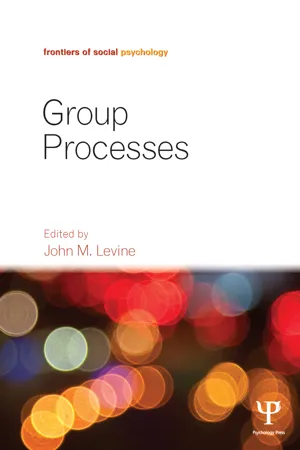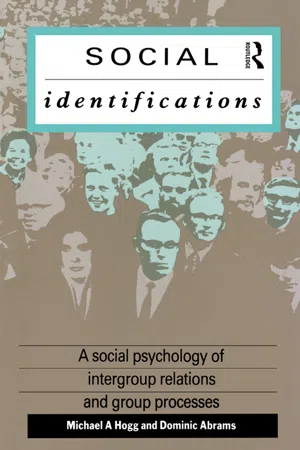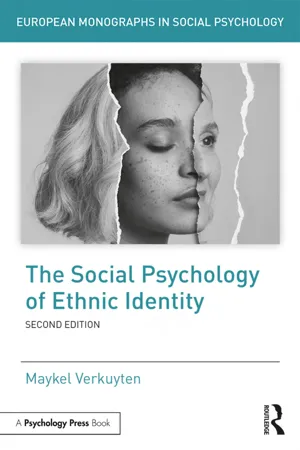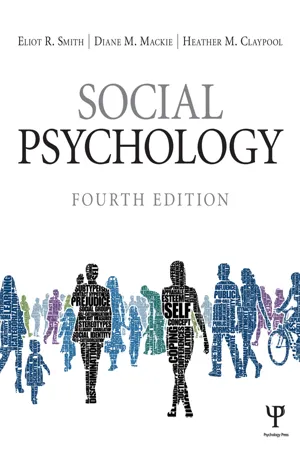Psychology
Social Identity Theory
Social Identity Theory, proposed by Henri Tajfel, suggests that a person's self-concept is based on their membership in social groups. It explains how individuals categorize themselves and others into in-groups and out-groups, leading to social comparison and the formation of stereotypes. The theory emphasizes the role of social context in shaping an individual's identity and behavior.
Written by Perlego with AI-assistance
Related key terms
Related key terms
1 of 4
Related key terms
1 of 3
11 Key excerpts on "Social Identity Theory"
- eBook - ePub
Contemporary Social Psychological Theories
Second Edition
- Peter J. Burke(Author)
- 2018(Publication Date)
- Stanford University Press(Publisher)
5 Social Identity Theory Michael A. Hogg INTRODUCTIONSocial Identity Theory is a social psychological analysis of the role of self-conception in group membership, group processes, and intergroup relations. It embraces a number of interrelated concepts and subtheories that focus on social-cognitive, motivational, social-interactive, and macrosocial facets of group life. The theory, which can be considered a midrange theory, is explicitly framed by a conviction that collective phenomena cannot be adequately explained in terms of isolated individual processes or interpersonal interaction alone and that social psychology should place larger-scale social phenomena near the top of its scientific agenda.Social Identity Theory defines group cognitively—in terms of people’s self-conception as group members. A group exists psychologically if three or more people construe and evaluate themselves in terms of shared attributes that distinguish them collectively from other people. Social Identity Theory addresses phenomena such as prejudice, discrimination, ethnocentrism, stereotyping, intergroup conflict, conformity, normative behavior, group polarization, crowd behavior, organizational behavior, leadership, deviance, and group cohesiveness.Social Identity Theory was first developed at the start of the 1970s in Britain by Henri Tajfel, out of his scientific and personal interests in social perception, social categorization, and social comparison and prejudice, discrimination, and intergroup conflict. Over the past forty-five years Social Identity Theory has attracted many collaborators and followers. It has developed and matured conceptually and has motivated, and continues to motivate, a prodigious quantity of research. Although initially a European analysis of intergroup relations, since the early 1990s it has become fully accepted around the world as one of mainstream social psychology’s most significant general theories of the relationship between self and group. However, this popularity has sometimes brought with it a disjunction between some readings of social identity concepts and the concepts themselves. - eBook - ePub
- John M. Levine(Author)
- 2012(Publication Date)
- Psychology Press(Publisher)
An important reason for this enormous influence and reach is that the social identity metatheory embraces sub-theories that deal with both the content and the context of group behavior. That is, the theory concerns the psychology that enables people to relate their group memberships to themselves as individuals and to society at large. Tajfel’s (1974, 1981) foundational theorizing generated two different aspects of the theory. Tajfel and Turner’s (1979) “Social Identity Theory of intergroup relations” was primarily concerned with the group and identity in the context of conflict and struggle between groups within a larger social structure. Turner’s (1985) “Social Identity Theory of the group”, ultimately emerging as self-categorization theory (Turner, Hogg, Oakes, Reicher, & Wetherell, 1987), developed a detailed account of the social-cognitive processes that underpin the psychological linkage between the self and a group. These two aspects of the theory provide the basis of a diverse array of more specific explanations for phenomena such as group cohesion, leadership, social influence, and the malleability of the self. Crucially, the overarching metatheory assumes that intergroup relations, intragroup relations, and the self are woven together in such a way that they can have reciprocal influence. This review summarizes the key concepts of the social identity approach within Social Identity Theory and self-categorization theory. It then considers the types of groups for which social identity is relevant, how social identity has been conceptualized and measured vis-a-vis other aspects of identity and cultural differences, and the motives associated with social identity - eBook - ePub
The New Psychology of Leadership
Identity, Influence and Power
- S. Alexander Haslam, Stephen D. Reicher, Michael J. Platow(Authors)
- 2020(Publication Date)
- Routledge(Publisher)
social competition.In terms of our present focus on leadership, Social Identity Theory makes four contributions that are essential for the analysis we want to develop. The first is to expound the central concept of social identity – the notion that our sense of self can be derived from our group membership and the meanings associated with that group membership. The second is to recognize that different forms of intergroup behavior stem from the definition of the norms and values associated with this social identity. The third is to establish that, when social identities are operative (or salient), what counts for an individual is the fate and the standing of the group as a whole, not his or her fate as an individual. The fourth is to observe that the nature of groups and of group processes is always bound up with social context. In particular, if the meaning of who we are depends on comparisons with “them,” then our own social identities will shift as a function of who we are comparing ourselves to in any given context.Social Identity Theory introduces us to these concepts, but they are more fully developed, made more explicit, and given wider application to group processes in general (including processes within groups as well as processes between groups) in a second phase of social identity theorizing. This phase centers around the development of self-categorization theory. This theory will be the focus of our interest in the remainder of this chapter because it provides us with the essential conceptual tools for crafting a new psychology of leadership.Self-categorization theory
Returning to the minimal group studies, for John Turner (1982) the most important implication of their findings was that they suggested that the mere act of individuals categorizing themselves as group members (i.e., defining themselves in terms of a given social identity) was sufficient to produce group behavior. What these studies showed very powerfully was that it was not interdependence, economic exchange, or attraction that led to group behavior but the cognitive process of defining oneself in terms of group membership. We only act as group members because, and to the extent that, we are able to think about ourselves as “we” and not just “I.” As Turner famously put it: “Social identity is the cognitive mechanism which makes group behavior possible - eBook - ePub
Social Identifications
A Social Psychology of Intergroup Relations and Group Processes
- Dominic Abrams, Michael A. Hogg(Authors)
- 2006(Publication Date)
- Routledge(Publisher)
theory in that it comprises a set of interrelated propositions from which empirically testable hypotheses can be generated. These two aspects are considered to be interrelated: theory can only be developed within the context of a distinct and explicit metatheory.For the remainder of this chapter we shall discuss the social identity approach: first at the level of metatheory (what kind of a theory is it?), and then at the level of theory (what does the theory itself say?). At this point it is important to differentiate between two uses of the term ‘social identity’. In the strict sense outlined above social identity is a formally defined and theoretically integrated set of processes and assumptions explaining the relationship between sociocultural forces and the form and content of individual social behaviour. It is used in a coherent theory formulated within a specific critique and specific model of the social world and is represented in a relatively clearly circumscribed literature (e.g. Tajfel 1978a, 1981a, 1982a; Turner and Giles 1981; Turner et al. 1987). The second, broadly descriptive usage of the term ‘social identity’ does not share our perspective, conceptual language, or theoretical propositions, and above all does not refer to the same literature (cf. Baumeister 1986, Sarbin and Scheibe 1983). However, this is not to say that the latter has no relevance to the former; it is merely that we believe that the former goes some if not a long way towards the development of a more theoretically integrated and truly social social psychology.Social identity: themes, questions, and context
The social identity approach rests upon certain assumptions concerning the nature of people and society, and their interrelationship. Specifically, it maintains that society comprises social categories which stand in power and status relations to one another . ‘Social categories’ refers to the division of people on the basis of nationality (British/French), race (Arab/Jew), class (worker/capitalist), occupation (doctor/welder), sex (man/woman), religion (Muslim/Hindu), and so forth, while ‘power and status relations’ refers to the fact that some categories in society have greater power, prestige, status, and so on, than others. Categories do not exist in isolation. A category is only such in contrast with another. For example, the social category ‘Black’ is meaningless unless it serves to differentiate between those who are ‘Black’ and those who are not—that is, a contrasting category. Any individual is at once a member of many different social categories (e.g. a male Buddhist Australian surfer), but is unlikely to be a member of mutually exclusive categories, such as Protestant and - eBook - ePub
The Construction of Exodus Identity in Ancient Israel
A Social Identity Approach
- Stargel(Author)
- 2018(Publication Date)
- Pickwick Publications(Publisher)
1The Social Identity Approach
S ocial identity was first defined as “that part of an individual’s self-concept which derives from his knowledge of his membership of a social group (or groups) together with the value and emotional significance attached to that membership.”1 That is to say, social identity was thought to include the following components:A cognitive component, in the sense of the knowledge that one belongs to a group; an evaluative one, in the sense that the notion of the group and/or of one’s membership of it may have a positive or a negative value connotation; and an emotional component in the sense that the cognitive and evaluative aspects of the group and one’s membership of it may be accompanied by emotions (such as love or hatred, like or dislike) directed towards one’s own group and towards others which stand in certain relations to it.2While this definition is still widely accepted, the term “social identity” has been used by a few to describe the gregarious aspect of individual identity. In response, some scholars have adopted the term “collective identity” to refer to group identity.3 Although this newer term provides clarity, both “social identity” and “collective identity” will be used interchangeably in this book since the former is used by the Social Identity Theory (SIT) and the Self-Categorization Theory (SCT), which are central to our methodology.Collective identity should not be equated with one’s beliefs, values, language, culture, and so on. People first come to the realization they are a distinct people and then they define themselves in relation to certain cultural indicia that change over time.4 Collective identity tends to be a dynamic entity, and not something static forced on groups by others or by circumstances. Such a view acknowledges groups as active agents in the making and remaking of their identities over time. Collective identities are perceived as identities that people “accept, resist, choose, specify, invent, redefine, reject, actively defend, and so forth. They involve an active ‘we’ as well as a ‘they.’ They involve not only circumstances but also active responses to circumstances by individuals and groups, guided by their own preconceptions, dispositions, and agendas.”5 This constructionist view of collective identities is presumed here. The validity of the assumption will be confirmed by findings of variability in identity formulations in exodus narratives.6 - eBook - ePub
- Joel Harvey, Derval Ambrose, Joel Harvey, Derval Ambrose(Authors)
- 2022(Publication Date)
- Routledge(Publisher)
3 Social Identity Theories Deborah Morris and Elanor WebbDOI: 10.4324/9781315560243-3Introduction
Group membership arises from an evolutionary need to belong, self-protect, survive, and thrive (Over, 2016 ). From our group membership, it is argued that individual self-concept, identity, beliefs, motivations, and behaviour can be understood. The relationship between ‘I’ and ‘we’, and how group membership impacts on self-identity and behaviour, is of long-standing interest to social psychologists (Hogg, 2018 ). Group membership and its relationship to self-concept and offending behaviour is also a core concern for those working with forensic populations.Group membership is broadly defined as a “set of individuals who hold a common social identification or view themselves as members of the same social category”1 (Stets & Burke, 2000 , p. 225). The criterion for social category is broad. It can range from temporary membership based on transient criteria and time-limited activities, through to more enduring, stable, or demographic membership variables. Group membership can also constitute the perception of a collective shared social identity (SI), which, in turn, can facilitate group behaviour (Hogg & Rinella, 2019 ). Social psychological experiments have consistently demonstrated that group membership has far-reaching consequences for self-concept, and for relationships and behaviour between and within groups across settings, including healthcare (Bochatay et al., 2019 ). While different theories have been developed to account for group behaviour and its relationship with self-concept, SI approaches remain the dominant ‘meta-theory’ (Hogg & Vaughn, 2018 ).Social Identity Theories
From their inception, SI theories have been concerned with attempting to account for the extreme behaviours of individuals enacted in the context of group membership. As such, they are well positioned to account for behaviours that fall outside of social norms, including offending in the context of mental disorder. They are rooted in post-World War II political dogma that attempted to understand Nazism and the psychosocial processes that made acts, such as genocide possible. In this context, initial models that focused on individual factors, such as the Authoritarian Personality (Adorno et al., 1950 ), were developed. They promoted the belief that behaviour in the Nazi regime was the manifestation of individual [personality] dysfunction- a belief that was consistent with post-war formulations that emphasised the ‘Germans are different’ hypothesis. Sherif’s (1966) - eBook - ePub
Leadership in Sports Coaching
A Social Identity Approach
- Paul Cummins, Ian O'Boyle, Tony Cassidy(Authors)
- 2017(Publication Date)
- Routledge(Publisher)
Leadership research has made strides over the years with specific recognition that, a) successful leadership depends on context, b) leadership is not a quality of leaders alone, but a quality of the relationship between leaders and followers, and c) leadership is not just about existing social realities but also about transforming social reality. Nevertheless, Haslam et al. (2011) critically suggest that leadership is not a relationship between leaders and followers, but a relationship between leaders and followers in a social group. Consequently, leadership cannot be fully understood outside of the group processes involved. SI theory is at the core of understanding the possibilities and limits of the group and investigating this theory and its relationship to leadership is the core of this research.Social Identity Theory
SI theory developed originally as a theory about intergroup relations (Tajfel and Turner 1979) but has since been applied to group processes in organizations (Hogg 2001). SI theory proposes that group members are naturally configured to maximize the proportion of between-group and within-group differences within a particular comparison context (Hogg and Abrams 1990; Hogg and Terry 2001; Hogg 2006). Essentially, SI theory refers to the individual’s knowledge that they belong to certain social groups and the emotional and value significance this group membership has for them (Tajfel 1982: 292). As a result, individuals are motivated to both defend and enhance a positive identity for the collective group.Consequently, when people are assigned to a group and adopt that group membership as the basis for their own subjective self-definition, two processes often subconsciously occur: a) they seek to determine the meaning and standing of the group by making social comparisons between their in-group and relevant out-groups (e.g. understanding what it means to be a Manchester United fan as opposed to a Manchester City fan), and b) they seek to define their in-group favourably by differentiating it positively from out-groups along their valued dimensions (e.g. seeing Manchester United supporters as more cohesive and loyal than Manchester City supporters) (Tajfel and Turner 1979). This condition is known as creating ‘positive distinctiveness’ and motivates the in-group to seek ways to define themselves more positively than a comparison out-group on some self-valued dimension. - eBook - ePub
- Maykel Verkuyten(Author)
- 2018(Publication Date)
- Routledge(Publisher)
but in what there is to be known about social categories . Social psychology has clearly shown that these are different things. An individual fits into many different categories, some of which are shared with some people and some shared with others, but never all of them shared with anyone else. A social category lumps together people who may be very different in all other respects. But what they share in characteristics through membership of the category, at least for the moment and for the purpose or circumstances of the designation, is supposed to outweigh all those differences.p.80 Three interrelated componentsSocial identity is about socially defined and recognized distinctions and designations. However, not all classifications into which a person fits become established and socially meaningful identities. We make lots of temporary and generalizing distinctions about ourselves and others all the time, such as in terms of mood, tastes and preferences. Social identities related to ethnicity, nationality, race and religion involve more enduring collective definitions and intersubjective understandings. For the membership of a collectivity of some sort to form a real social identity, a combination of three interrelated related components is needed:(1) social classification, or the sociostructural component;(2) specific behavioural and normative consequences and expectations bounded to the category, or the cultural component; and(3) judgements of an ontological nature , or the ontological component.Together, these three are the necessary aspects of social identities. Obviously, the three are closely linked. It is the combination of the three that gives a social label the required ‘identity depth’. Hence the distinction is an analytic one that allows us to ask specific questions and examine interrelations.Gender identity is a ready example. There are no cultures in the world that do not make a clear distinction (1) between men and women in their classification of things, (2) in the way in which the two sexes are expected to behave and (3) in what they are supposed to be like as human beings. The identity potential of the sex difference is enormous. This does not mean that the characteristics imposed or expected to exist are in any way natural or inevitable. Even here, although the role differentiation is biologically given to a certain extent, there are extreme differences between cultures in prescribed behaviour for the sexes and in gender-related development. I will elaborate on these three components in the next sections. - eBook - ePub
The New Psychology of Health
Unlocking the Social Cure
- Catherine Haslam, Jolanda Jetten, Tegan Cruwys, Genevieve Dingle, S. Alexander Haslam(Authors)
- 2018(Publication Date)
- Routledge(Publisher)
Chapter 1 . In particular, this is because they challenge the dominant model of the self that prevails in psychology (and in Western society as a whole) which sees the true nature of the person as residing in their immutable individuality, and hence which sees pathways to health as largely requiring engagement with, and mobilisation of, this individuality and an associated sense of personal identity.The alternative view that we have set out does not question the importance of individuality or personal identity for our sense of personhood or for our behaviour. However, it suggests that this is most likely to have an impact on health and well-being where it emerges out of, rather than independently of, meaningful group memberships (Greenaway et al., 2015; Jetten et al., 2015). Indeed, more generally, we suggest that people’s internalised group memberships – that is, their social identities – can be an essential source of psychological robustness and resilience. In large part this is because, as we have seen, social identities constitute key psychological resources of the form summarised in Figure 2.8 . Moreover, as well as being psychological, these resources have important material consequences for the groups they are members of and for the social world that those groups are part of.This can be seen clearly in each of the three examples with which we started this chapter. In Sardinia, the residents of the mountain villages are observed to have a fierce and proud sense of their shared and distinctive identity (Pinker, 2015); at the Magh Mela pilgrims revel in the opportunity to live out their shared religious faith (Tewari et al., 2012); in outback Australia resilient farmers report feeling a strong sense of belonging with others in their community that helps them to cope with the adversity of drought and hardship (McLaren & Challis, 2009; McPhedran & De Leo, 2013b; Schirmer, Mylek, Peel, & Yabsley, 2015). In all these cases it is not simply personal resilience or hardiness that protects health; rather this seems to flow from depersonalised connections between people that are a source of support, solidarity, and strength. - Constantine Sedikides, Marilynn B. Brewer, Constantine Sedikides, Marilynn B. Brewer(Authors)
- 2015(Publication Date)
- Psychology Press(Publisher)
The self-categorization process is even more striking when we consider the change in self-category content as we moved from personal to social identity. The observation that social identity functioned to the exclusion of the personality variable is important. This finding clearly challenges the long-standing assumption in social psychology that the self can be conceived as fixed at the personal level.This study and others like it suggest that change and stability in the self can be understood in terms of implicit and explicit self-categorization processes. Clearly, much more work needs to be done, particularly with regard to developing and testing an adequate process-based (as opposed to structural) account of stability in self-relevant judgments. Nevertheless, our research suggests the viability of such an account. Moreover, it supports the general conclusion that the self is the expression of a flexible process of social judgment (Turner et al., 1994).Figure 9.1. Contextual interpretation of schema-type effects in a modified version of the Markus paradigm.CONCLUSION
Gordon Allport once stated “the existence of one’s own self is the one fact of which every mortal person—every psychologist included—is perfectly convinced” (1943, p. 451). Despite this consensus, the question of precisely what form the self takes remains a topic of much debate. It can be argued that the cognitive revolution in social psychology has produced a dramatic shift away from the more “contextualist” perspectives of the early theorists (Rosenberg, 1988). The self-concept currently is conceived as a stable, separate, and bounded cognitive structure. Personality theories of the self and questions about how self-relevant knowledge is mentally organized and processed have taken center stage. Not surprisingly then, self-concept change has come to be understood as a matter of reconfiguring the personality structures that constitute the self-concept. The relevant theoretical models and experimental paradigms have tended to neglect the pervasive influence of the other and the psychological group on the phenomenal self. In this chapter, we have argued that, at some level, the psychological group (in the general sense of an abstract “us,” or in the more particular sense of a specific group membership) is implicated in the experience of all self-concepts. This idea is at the foreground of self-categorization theory, but has not, in our view, penetrated mainstream social cognition research on the self. Insofar as attention is refocused on the nexus between the psychological group and the self-concept, the field of social psychology arguably will be in a good position to achieve a more adequate integration of the social and the cognitive aspects of the self and understand better the forces making for self-concept stability and change.- eBook - ePub
Social Psychology
Fourth Edition
- Eliot R. Smith, Diane M. Mackie, Heather M. Claypool(Authors)
- 2014(Publication Date)
- Psychology Press(Publisher)
The chapter concludes with a discussion of the effects of belonging to a group that others look down on. From playgrounds to boardrooms, being Muslim, speaking with an accent, using a wheelchair, being gay or lesbian, or being on welfare can provoke scorn, dislike, and avoidance. Such negative group identities can take their toll on individuals and groups. But this outcome is not inevitable, and the chapter concludes by describing how people resist the implications of a negative identity and even work to change society’s evaluation of their groups.CATEGORIZING ONESELF AS A GROUP MEMBER
Some group memberships are so important that they become a basic part of our view of ourselves. Try asking a friend to take a piece of paper and write 10 different sentences beginning “I am …” When people perform this task they typically list some individual characteristics such as “I am outgoing” or “I am tall,” but they also list group memberships: “I am a woman,” “I am German.” In fact, most people list more group than individual characteristics (M. H. Kuhn & McPartland, 1954). The process of seeing oneself as a member of a group is known asself-categorization(J. C. Turner, Hogg, Oakes, Reicher, & Wetherell, 1987). Self-categorization is flexible and can readily shift (Mussweiler, Gabriel, & Bodenhausen, 2000). Depending on the social context, for example, sometimes you may see yourself as a Mexican-American, other times as a student, and still other times as a unique individual, with group memberships temporarily receding into the background. The termsocial identityrefers to the way we feel about the group memberships that we share with others (M. Rosenberg, 1979; Tajfel, 1972). Social identity turns “I” into “we”; it extends the self out beyond the skin to include other members of our groups—and, as we will see, it generally involves positive feelings about both ourselves, and those others.self-categorizationthe process of seeing oneself as a member of a social groupsocial identitythose aspects of the self-concept that derive from an individual’s knowledge and feelings about the group memberships he or she shares with othersAlthough some group memberships are only fleetingly important—being part of the “white shirts” team in a lunch-hour basketball game, for example—most group memberships are stable and enduring. Membership in gender and ethnic groups lasts a lifetime. Being a member of the Kardashian or the Hilton family, or being Muslim, Roman Catholic, or Buddhist can be just as long-lasting. How do we learn what characteristics are associated with our groups?
Index pages curate the most relevant extracts from our library of academic textbooks. They’ve been created using an in-house natural language model (NLM), each adding context and meaning to key research topics.
Explore more topic indexes
Explore more topic indexes
1 of 6
Explore more topic indexes
1 of 4










